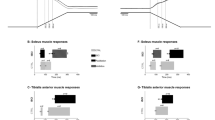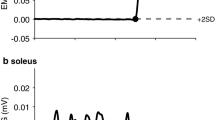Abstract
Hereditary spastic paraplegia (HSP) is characterized by progressive lower extremity spasticity and weakness, due to retrograde axonal degeneration of the corticospinal tract and posterior spinal columns. HSP patients fall frequently. We hypothesized that delayed postural responses contribute to their balance impairments. To distinguish between a delay in afferent and efferent signals, we combined postural responses with a startling acoustic stimulus (SAS). The SAS triggers a postural response directly, bypassing afferent proprioceptive input. We performed two experiments. First, 18 HSP patients and nine healthy controls stood on a balance platform and were instructed to counteract forward and backward balance perturbations, without taking a step or grabbing a handrail. Second, 12 HSP patients and nine controls received backward perturbations, while a SAS accompanied onset of platform motion in 25 % of trials. HSP patients were less successful than controls in maintaining balance following backward and forward perturbations. Furthermore, latencies of postural responses were significantly delayed in HSP-patients, by 34 ms in gastrocnemius following forward, and by 38 ms in tibialis anterior following backward perturbations. A SAS accelerated postural responses in all participants, but more so in HSP patients whose latencies were normalized. Our results suggest that delayed postural responses in HSP patients contribute to their balance problems. Combining balance perturbations with a SAS restored normal latencies, suggesting that conduction of efferent signals (presumably by the reticulospinal tract) is normal. We therefore suggest that the delayed postural responses in HSP are caused by slowed conduction time via the posterior spinal columns.



Similar content being viewed by others
References
Berg KO, Wood-Dauphinee SL, Williams JI, Maki B (1992) Measuring balance in the elderly: validation of an instrument. Can J Public Health 83(Suppl 2):S7–11
Bohannon RW, Smith MB (1987) Interrater reliability of a modified ashworth scale of muscle spasticity. Phys Ther 67:206–207
Bonsch D, Schwindt A, Navratil P, Palm D, Neumann C, Klimpe S, Schickel J, Hazan J, Weiller C, Deufel T, Liepert J (2003) Motor system abnormalities in hereditary spastic paraparesis type 4 (SPG4) depend on the type of mutation in the spastin gene. J Neurol Neurosurg Psychiatry 74:1109–1112
Cameron MH, Horak FB, Herndon RR, Bourdette D (2008) Imbalance in multiple sclerosis: a result of slowed spinal somatosensory conduction. Somatosens Mot Res 25:113–122
Council MR (1981) Aids to the examination of the peripheral nervous system. Her Majesty’s Stationery Office, London, p 1981
Davis JR, Carpenter MG, Tschanz R, Meyes S, Debrunner D, Burger J, Allum JH (2010) Trunk sway reductions in young and older adults using multi-modal biofeedback. Gait Posture 31:465–472
Davis RB, Ounpuu S, Tyburski D, Gage JR (1991) A gait analysis data-collection and reduction technique. Hum Movement Sci 10:575–587
de Niet M, Weerdesteyn V, de Bot ST, van de Warrenburg BP, Geurts AC (2013) Does calf muscle spasticity contribute to postural imbalance? A study in persons with pure hereditary spastic paraparesis. Gait Posture. doi:10.1016/j.gaitpost.2012.12.006
Dimitrijevic MR, Lenman JA, Prevec T, Wheatly K (1982) A study of posterior column function in familial spastic paraplegia. J Neurol Neurosurg Psychiatry 45:46–49
Harding AE (1983) Classification of the hereditary ataxias and paraplegias. Lancet 1:1151–1155
Harding AE (1993) Hereditary spastic paraplegias. Semin Neurol 13:333–336
Hermens HJFB, Merletti R et al (1999) SENIAM 8: european recommendations for surface electroMyoGraphy roessingh research and development bv. Enschede, The Netherlands
Hof AL (2008) The ‘extrapolated center of mass’ concept suggests a simple control of balance in walking. Hum Mov Sci 27:112–125
Hof AL, Gazendam MG, Sinke WE (2005) The condition for dynamic stability. J Biomech 38:1–8
Honeycutt CF, Gottschall JS, Nichols TR (2009) Electromyographic responses from the hind limb muscles of the decerebrate cat to horizontal support surface perturbations. J Neurophysiol 101:2751–2761
Horak FB, Dozza M, Peterka R, Chiari L, Wall C 3rd (2009) Vibrotactile biofeedback improves tandem gait in patients with unilateral vestibular loss. Ann N Y Acad Sci 1164:279–281
Huffman JL, Norton LE, Adkin AL, Allum JH (2010) Directional effects of biofeedback on trunk sway during stance tasks in healthy young adults. Gait Posture 32:62–66
Jacobs JV, Horak FB (2007) Cortical control of postural responses. J Neural Transm 114:1339–1348
Jorgensen LM, Nielsen JE, Ravnborg M (2005) MEP recruitment curves in multiple sclerosis and hereditary spastic paraplegia. J Neurol Sci 237:25–29
McDermott C, White K, Bushby K, Shaw P (2000) Hereditary spastic paraparesis: a review of new developments. J Neurol Neurosurg Psychiatry 69:150–160
Nanhoe-Mahabier W, Allum JH, Pasman EP, Overeem S, Bloem BR (2012) The effects of vibrotactile biofeedback training on trunk sway in Parkinson’s disease patients. Parkinsonism Relat Disord 18:1017–1021
Nardone A, Galante M, Lucas B, Schieppati M (2001) Stance control is not affected by paresis and reflex hyperexcitability: the case of spastic patients. J Neurol Neurosurg Psychiatry 70:635–643
Nardone R, Tezzon F (2003) Transcranial magnetic stimulation study in hereditary spastic paraparesis. Eur Neurol 49:234–237
Nonnekes J, Scotti A, Oude Nijhuis LB, Smulders K, Queralt A, Geurts AC, Bloem BR, Weerdesteyn V (2013) Are postural responses to backward and forward perturbations processed by different neural circuits? Neuroscience 245:109–120. doi:10.1016/j.neuroscience.2013.04.036
Pelosi L, Lanzillo B, Perretti A, Santoro L, Blumhardt L, Caruso G (1991) Motor and somatosensory evoked potentials in hereditary spastic paraplegia. J Neurol Neurosurg Psychiatry 54:1099–1102
Pestronk A, Florence J, Levine T, Al-Lozi MT, Lopate G, Miller T, Ramneantu I, Waheed W, Stambuk M (2004) Sensory exam with a quantitative tuning fork: rapid, sensitive and predictive of SNAP amplitude. Neurology 62:461–464
Polo JM, Calleja J, Combarros O, Berciano J (1993) Hereditary “pure” spastic paraplegia: a study of nine families. J Neurol Neurosurg Psychiatry 56:175–181
Prentice SD, Drew T (2001) Contributions of the reticulospinal system to the postural adjustments occurring during voluntary gait modifications. J Neurophysiol 85:679–698
Queralt A, Weerdesteyn V, van Duijnhoven HJ, Castellote JM, Valls-Sole J, Duysens J (2008) The effects of an auditory startle on obstacle avoidance during walking. J Physiol 586:4453–4463
Salinas S, Proukakis C, Crosby A, Warner TT (2008) Hereditary spastic paraplegia: clinical features and pathogenetic mechanisms. Lancet Neurol 7:1127–1138
Sartucci F, Tovani S, Murri L, Sagliocco L (2007) Motor and somatosensory evoked potentials in autosomal dominant hereditary spastic paraparesis (ADHSP) linked to chromosome 2p, SPG4. Brain Res Bull 74:243–249
Schepens B, Drew T (2006) Descending signals from the pontomedullary reticular formation are bilateral, asymmetric, and gated during reaching movements in the cat. J Neurophysiol 96:2229–2252
Schepens B, Drew T (2004) Independent and convergent signals from the pontomedullary reticular formation contribute to the control of posture and movement during reaching in the cat. J Neurophysiol 92:2217–2238
Valls-Sole J, Kumru H, Kofler M (2008) Interaction between startle and voluntary reactions in humans. Exp Brain Res 187:497–507
Verhoeff LL, Horlings CG, Janssen LJ, Bridenbaugh SA, Allum JH (2009) Effects of biofeedback on trunk sway during dual tasking in the healthy young and elderly. Gait Posture 30:76–81
Wall C 3rd, Kentala E (2005) Control of sway using vibrotactile feedback of body tilt in patients with moderate and severe postural control deficits. J vestib res equilib orient 15:313–325
Acknowledgments
This research was funded by a Radboud University Nijmegen Medical Centre Research Grant to JN, and a Netherlands Organization for Scientific Research Veni Research Grant (916.10.106) to VW. BRB was supported by a research grant from the Netherlands Organization for Scientific Research (016.076.352). We thank Roland Loeffen for technical assistance.
Conflicts of interest
On behalf of all authors, the corresponding author states that there is no conflict of interest.
Author information
Authors and Affiliations
Corresponding author
Rights and permissions
About this article
Cite this article
Nonnekes, J., de Niet, M., Nijhuis, L.B.O. et al. Mechanisms of postural instability in hereditary spastic paraplegia. J Neurol 260, 2387–2395 (2013). https://doi.org/10.1007/s00415-013-7002-3
Received:
Revised:
Accepted:
Published:
Issue Date:
DOI: https://doi.org/10.1007/s00415-013-7002-3




